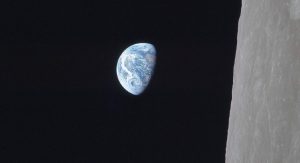
“This transmission is coming to you approximately halfway between the moon and the Earth.”
Those words, beamed down by three brave souls traveling through a vacuum, reverberating around the world during Christmas of 1968 – a tumultuous year in our history, to say the least. Tensions between the United States and the Soviet Union escalated, as did the turbulent war in Vietnam. Mass revolts and general political unrest led to the country being “at its most divided since the Civil War.” Leaving human turmoil behind, astronauts Frank Borman, Bill Anders, and James Lovell ventured into the eternal darkness of space, marking humanity’s first-ever journey to the moon. Filmmaker Paul J. Hildebrandt – who produced, shot, directed and edited First to the Moon, his second documentary about the Space Race after 2016’s Fight for Space – captures their adventure in extraordinarily vivid detail, but also examines the impact it had on unifying our lacerated planet. As Captain James A. Lovell states: “We went to the moon but what we really discovered was the Earth.”
Hildebrandt travels from Illinois to Montana and Washington to speak with the three American heroes. Sharp, eloquent and charming, they fondly recollect the early days, prior to their paths converging for the famed Apollo 8 mission. There’s Jim Lovell, who, inspired by Charles Lindbergh’s flight across the Atlantic, pursued his dream of aviation, becoming a U.S. Navy test pilot until NASA selected him from a robust pool of candidates for the perilous Apollo mission. There’s aeronautical engineer Frank Borman, whose passion for planes (over rockets) eventually led him to become a “Zero-G” test pilot. And then there’s Major William A. Anders, born in Hong Kong and whose father fought in Pearl Harbor; Bill got a ride in a bi-plane as a youngster, and the rest is history.

“We went to the moon but what we really discovered was the Earth.”
In 1961, Soviet Cosmonaut Yuri Gagarin beat the Americans to become the first person in space. Kennedy promptly made a speech about sending a man to the moon before the end of the decade. Jim and Frank, traveling incognito, met at a hotel under utter secrecy, along with a dozen other selectees, to get started on the Gemini program: a 14-day space flight to get acquainted with the hazardous environment. “I’ve never been in a rocket before,” Jim recollects. “It was a hell of a booster to ride.” Frank likens it to being “in the front seat of a Volkswagen for two weeks.”
Soon after, Frank was selected to head the Apollo 8 mission, “to go around the moon before the Russians did.” With Bill and Jim onboard, the team began preparing for the record-breaking flight – so “absorbed by beating the Russians,” that the Kennedy assassination, Vietnam riots, and the Cold War became a background blur. On December 21st, 1968, Apollo 8 departed for the moon, its launch “so noisy, you couldn’t speak or think.” As the Earth grew smaller and smaller behind them, things like politics and religion began to seem comparatively minuscule to the men. Hildebrandt presses the pedal to the metal in the film’s final third, his doc growing increasingly intense – despite us all knowing the outcome – as our heroes enter the shadow of the moon, its umbra, wherein the velvet blackness of space, the stars shine most radiantly. The feeling of awe our heroes experience upon witnessing the first glimpse of the moon (on Christmas, no less!) is so tangible. It’ll make you feel like you’re there, in the tiny space capsule with them.
Hildebrandt does a fantastic job stringing together archival footage and talking heads into a compelling two-hour narrative. “Poised like a giant white dart,” the Apollo Saturn 5 vehicle is a sight to behold; shivers run down your spine at the thought of this 36-story-high machine accumulating “seven and a half million pounds of thrust” to break through stratospheric boundaries and propel human beings into the orbit within 11 minutes. The filmmaker got access to some incredible shots of the men riding up the elevator and being stuffed into their seats, all the while listening to a static voice counting down minutes to their potential demise. The stunning black-and-white / color footage from inside the spacecraft includes the famous shot of our Earth, “about the size of a fist at arm’s length,” as well as “Earthrise,” a photo of the Earth rising behind the moon, hastily taken by Bill Anders. There are plenty of other visual marvels: Yuri Gagarin’s first space flight; the astronauts’ grueling training; planes landing (or failing to land) on aircraft carriers; and the astronauts’ dangerous reentry into the Earth’s atmosphere.
“Hildebrandt does a fantastic job stringing together archival footage and talking heads into a compelling two-hour narrative.”
The most fascinating bits come from the astronauts themselves. “It was a revealing time,” Frank refers to his discovery of flimsy American assembly in a blown-up command module, insinuating that rushing / beating the Russians was prioritized over safety. Frank’s waxing poetic about his “Zero-G” flight-testing days also resonates: “At about 65,000 feet the afterburner blew up, at about 75,000 feet you had to shut the engine off because it got too hot, [then you’d float] at about 90,000 feet, then you came back down, relit the engine and landed.” He speaks of his plane literally exploding at Mach-2 speeds as “an exciting time.” Jim Lovell recalls following the shimmering algae trail of a large carrier in a broken-down, pitch-black plane, then landing it on said vessel.
Yet it’s Bill Anders who’s perhaps the most wistful of the three. He remembers pulling up next a Russian bomber, expecting them to act violently, but instead receiving smiles and waves. “I’ve always thought you know more about your enemies than you know about your friends,” he says. “Our enemies back in those days, in my view, were much more worthy than some of the so-called ‘friends’ we joined up with later… They were all very nice guys, and very much like we were.” Later, he quietly states: “Looking back, the Cold War seems kind of silly.”
First to the Moon moves at rocket-launch speed, chockfull of engrossing episodes: Frank’s vomit floating through zero gravity (“A three-dimensional, multicolored, oscillating ball,” as Bill describes it); or sharks circling the returned astronauts rendering exiting the spacecraft impossible..From examining the larger-scope political ramifications of their journey to studying its minute details, Hildebrandt’s doc’s an ode to our capabilities as a race and a reminder of the power of uniting to pursue the same grandiose goal. “God has given us a stage to perform,” Jim says. “And how it comes out is up to us.” First to the Moon may not mark a giant leap for documentary filmmaking, but it’s bound to be more than just a small step in Hildebrandt’s career.

First to the Moon (2019) Directed by Paul J. Hildebrandt. Featuring Bill Anders, Frank Borman, Jim Lovell.
9 out of 10

